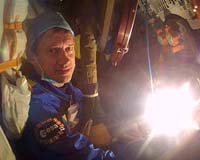 |
Washington (AFP) Sept 3, 2009 A large piece of space debris drifted toward the International Space Station Thursday, but NASA said it would not affect the second of three spacewalks outside the orbiter. "Mission control evaluated a piece of space junk and decided it's not necessary to move the space shuttle/space station to avoid it," NASA said on its Twitter feed. Astronauts Danny Olivas and Christer Fuglesang were camping out in a decompression chamber in order to acclimatize their bodies for their 2119 GMT outing in space, purging nitrogen from their systems. Mission Control was keeping a close watch on the remains of the three-year-old Ariane 5, a European space rocket, that were moving in an oval-shaped orbit. The piece, which is some 200 square feet (19 square meters) large, was expected to pass almost two miles (three kilometers) from the outpost on Friday, the US space agency said. Mission Control was developing a contingency plan to potentially "reboost" the station-shuttle complex that currently holds 13 astronauts if the space junk posed a threat. The linked spacecraft are currently orbiting 220 miles (354 kilometers) above the Earth. During their 6.5-hour spacewalk Olivas -- the mission's lead spacewalker -- and Sweden's Fuglesang were to install a new liquid ammonia tank used to keep the ISS cool. Veteran US spacewalker Olivas will be wearing a suit marked with red stripes while Fuglesang will don an all-white spacesuit. Astronauts Kevin Ford and Nicole Stott will drive the robotic arm carrying Fuglesang and both the old and new ammonia tanks to the installation site on an ISS truss segment. After installing the massive, 800-kilogram (1,760-pound) tank, Olivas and Fuglesang will work to unlatch the old tank and place it in the shuttle's cargo bay with the help of the robotic arm. On Wednesday, Olivas and Stott performed the first spacewalk of the shuttle Discovery's nine-day mission at the ISS, removing an old tank from the outpost's truss. The tank will return to Earth with Discovery. The duo also fetched US and European experiment equipment from the orbiting station's Columbus laboratory that will be brought back to scientists on Earth. Discovery's mission is the fourth of five planned for the shuttle program this year. The last is scheduled for November. The two crews continued unloading equipment from the Leonardo Multi-Purpose Logistics Module, a huge pressurized chamber carrying 7.5 tons of supplies, including new station crew quarters, a freezer, two research racks and a treadmill named after popular US talkshow comedian Stephen Colbert. The freezer will store samples of blood, urine and other materials that will eventually be brought back to Earth for study on the effects of zero-gravity. Discovery, which will remain docked at the ISS until Tuesday, is due to return to Earth on September 10. The mission is the 128th for the space shuttle program, and the 30th mission to the ISS. Once the Discovery mission is complete, just six more shuttle flights remain before NASA's three shuttles are retired in September next year. Stott is taking over at the ISS from engineer Tim Kopra, who has been aboard the orbiting laboratory since July and is slated to return to Earth with the shuttle. Share This Article With Planet Earth
Related Links Station at NASA Station and More at Roscosmos S.P. Korolev RSC Energia Watch NASA TV via Space.TV Space Station News at Space-Travel.Com
 ESA Astronaut Answers Your Questions From Space
ESA Astronaut Answers Your Questions From SpaceParis, France (ESA) Sep 03, 2009 How do you wash your clothes in space? How does food stay fresh if there is no fridge on the ISS? ESA"s Frank De Winne is answering these, and many more of your questions, right now, from space. Is there something you always wanted to know about being an astronaut? Or you are just curious about living and working in space? Well, now is the time to ask. Instead of searching the Internet ... read more |
|
| The content herein, unless otherwise known to be public domain, are Copyright 1995-2009 - SpaceDaily. AFP and UPI Wire Stories are copyright Agence France-Presse and United Press International. ESA Portal Reports are copyright European Space Agency. All NASA sourced material is public domain. Additional copyrights may apply in whole or part to other bona fide parties. Advertising does not imply endorsement,agreement or approval of any opinions, statements or information provided by SpaceDaily on any Web page published or hosted by SpaceDaily. Privacy Statement |